Halting Time through the Illusion of Portraiture
Text by Barbara Luck
Photos by Hans Lorenz
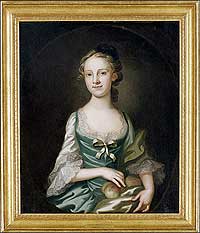
About 1757, John Wollaston
Jr. painted a girl believed to be Elizabeth Dandridge.
Images
of loved ones have universal appeal,
but portraits of children occupy a special niche among our tangible treasures.
Late eighteenth- and early nineteenth-century parents commissioned likenesses
of their offspring for the same reasons that prompt us to bedeck our youngsters
in Sunday-best attire and haul them off to the photographer's, if not the
portrait painter's. But higher mortality rates made earlier parents keenly
aware of the ephemeral nature of life, and perhaps sharpened the sense of
urgency with which they sought to halt time through the illusion of
portraiture.
Portrait prices varied. Besides their inevitable tie
to the prevailing economy, they also derived from the portraitist's skills, his
degree of financial desperation, the size and format of the likeness, and the
materials employed. Oil paintings, such as those shown in these pages, were
invariably more expensive than works on paper. Their pigments and canvas or
wooden supports cost more than paper and the media used on it. Tradition and
fashion also dictated that oils be executed in roughly standard sizes that,
compared to works on paper, were rather formidable. Few folk in cottages could
afford oil portraits; they also lacked suitable display space for them.
Nevertheless, the expanding dispersal of wealth in America enabled growing
numbers of middle-class parents to attain their hearts' desire of an impressive
oil likeness of little Mary, Charles, or Walter.
Whether that likeness was bust-, half-,
three-quarter, or full-length related, to some degree, to changing tastes.
Bust- and half-length portraits gained favor as popular attention focused
increasingly on sitters' personalities and psyches. Yet full-length portraits
of children never really went out of style. The relative immaturity of
youngsters' inner natures may have been a factor, but full-length formats also
emphasized children's diminutive stature, surely an aspect of their appearance
that parents and other doting adults found endearing.
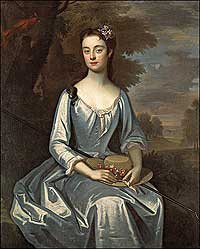
A young
woman of elegance and pedigree, Evelyn Byrd was about eighteen when her
portrait was painted ca. 1725. The straw hat and gardening tool in her lap tie
her to a simple existence in nature; her satin dress connotes a comfortable life.
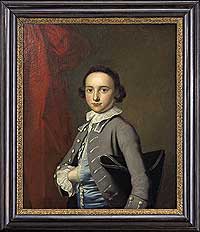
David Meade Jr. was painted by Thomas Hudson about 1752, when he would have been ten. Born in Nansemond
County, Virginia, the boy was sent to England by his parents for his health and
for schooling at Harrow.
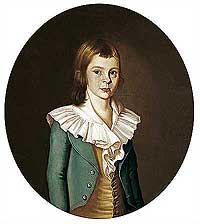
Charles and Mary Ann
Bacon's portraits are part of a set including their parents and a sister
painted by William Jennys in 1785.
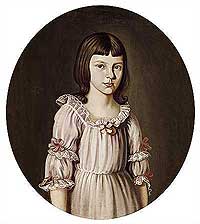
The two children in this painting from Boston about 1760 show a less-polished and individual style than Jennys's.
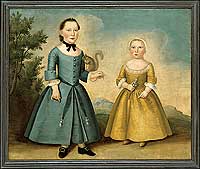
The two children in this painting from Boston about 1760 show a less-polished and individual style than Jennys's.
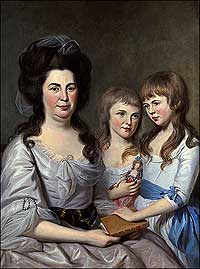
Charles Willson Peale's portrait of Mrs. Robert Gilmour with daughters Jane and
Elizabeth, ca. 1788.
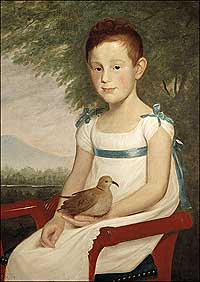
A wood panel painting of a young girl by Cephas Thompson, ca. 1805.
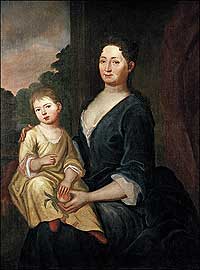
Charles Bridges's portrait of Mrs. Augustine Moore and her child in
Virginia.
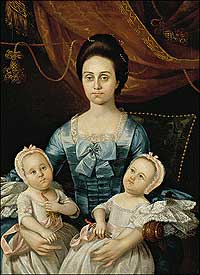
Twins Sarah and Ann with their mother, Elizabeth Gay Bolling, by
Mathew Pratt, 1773.
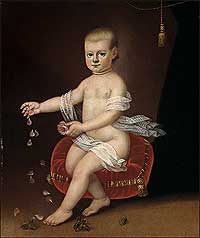
In this 1772 portrait by
Jeremiah Theus, the falling rose petals suggest the child from Charleston,
South Carolina, may have died.
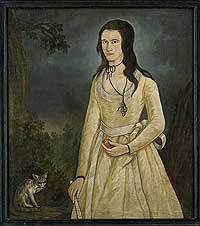
Martha Payne's portrait, ca.
1789-91, is one of ten of her family executed by a painter known only as the Payne Limner.

All photographs and digital images © The Colonial Williamsburg Collection. Not for reproduction or publication.
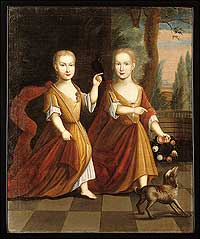
"Portrait of the Depeyster Twins, Eva and Catherina" was painted by Depeyster Limner circa 1728 in New York. Although the children seem a bit stiff, there is evidence of movement and animation in the fabric swirling around them, the gestures of the children, the bird perched on a hand, and the lively dog.
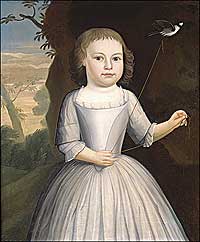
Oil on canvas portrait titled “Unidentified Child” was painted by James Peale circa 1770 – 1775 and is part of Colonial Williamsburg’s Bassett Hall Collection.
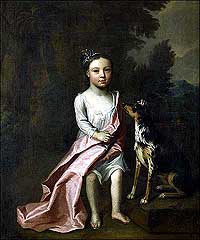
“Portrait of Anne Byrd” by Charles Bridges was painted circa 1735 and reveals that beloved pets were part of family life in the 18th century.
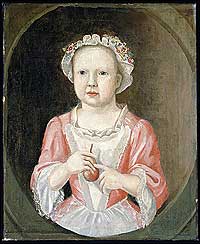
Joseph Badger of Charlestown, Massachusetts, was a house painter who later turned to portrait painting. Badger painted “Elizabeth Greenleaf” in oil sometime around 1750. The painting was a gift of Abby Aldrich Rockefeller.
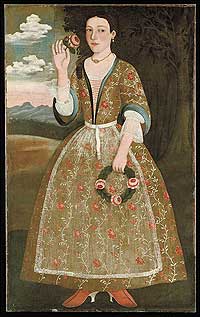
“Deborah Glen” was the daughter of a wealthy army colonel who amassed a fortune and extensive landholdings. Her elaborate dress shown in this oil portrait provides tangible evidence of the family’s wealth.
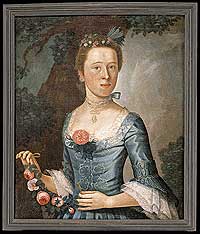
John Durand’s 1753 “Portrait of Elizabeth Boush ” indicates the ideal of proper deportment for 18th-century young ladies – head held erect and shoulders back – to convey an attitude of alertness.
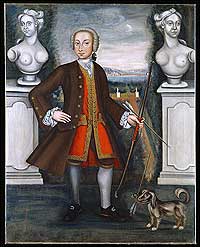
"Portrait of George Booth" by William Dering portrays a stylish, self-assured young man. The formal garden in the background reveals Booth's elite social status.



















